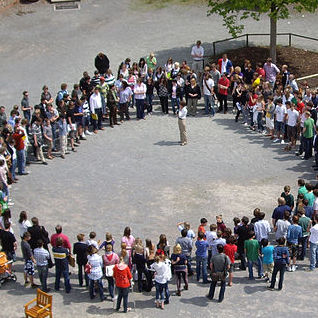
TARGET GROUP
More infos to group sizetheoretically no maximum, but for topics that need deeper sharing of thoughts and explanations it is good not to be more than 40 persons. Is participant experience relevant?It's okay if participants haven't seen the inside of a classroom in years. Physical trust needed
Mental trust needed
REQUIREMENTSDuration30 minutes – 2 hours Experience level of the facilitatorroutine as participant OR professional facilitator Number of facilitators1 Location requirementsflat ground and a lot of space, either outdoor or in a large room with furniture aside. CHARACTER OF THE METHODLevel of activationactivatingHidden curriculum-Every voice is worth being heard, everyone has the right to be listened to. Woo-Woo Level – How touchy-feely is this method?From 1.Rationalist-Materialist “No feelings here, folks.” to 5.Esoteric-Shamanic Bleeding Heart: Innovation Phases:• 2 Creating an Innovation-Friendly Culture Method Category:• Appreciative / Community building |
SHORT DESCRIPTIONSoft shoe shuffle is a group conversation in motion. It is an effective and energizing method for -sharing insights or discussing controversial topics in a group, -for group decision making -and to bring a fresh wind into encrusted conversation habits. BACKGROUNDBACKGROUND AND PURPOSESoft shoe shuffle is a practice of Deep Democracy. Deep Democracy is a methodology developed to foster a deeper level of dialogue, inviting a variety of opinions in a safe environment. We have seen stuck group decisions with a few filibusters dominating the discussion turn into a lively process with a quick resolution everyone could go with - just by shifting from a plenum discussion to a soft shoe shuffle process. ORIGINAL SOURCEIt is adapted from the process-oriented work of psychologist Arnold Mindell (http://www.aamindell.net) and has been developed further by Myrna Lewis (http://deep-democracy.net) STEP-BY-STEP GUIDEPREPARATION (excluding materials)Can be done on the spot, no preparation needed. 1 Clarify the topicClarify the topic/question you want to explore or find a solution for. Write it on a flipchart. 2 Getting startedAsk the group to stand up and spread out in the room. 3 Work an exampleRead out loud your common question or unfinished sentence. Have one of the people in the group offer an observation/statement about the issue that is being discussed. 4 Support the discussionGet a feel for the process. Sometimes it is just fine to hear the statements and see the group move accordingly. Especially in decision processes this might be enough and the group automatically finds a statement everyone can agree on and a decision is found. In soft shoe shuffles that are more about exploring a topic or sharing insights and opinions you could support the group with a few facilitation interventions. Here are some suggestions: -Invite further exploration. For example, look at the people who are farthest away. Ask them if they would share why they are standing -Inviting quiet people: Don't ask a quiet person directly, but something like "Does any one of those who have been quiet so far want to share?" Look for eye contact with some of the people who haven't said anything so far. 5 EndingThere are 3 good moments for an end: In cases of 2 or 3, you can end with a statement that is good for closing. Make sure not to stop in the midst of a very controversial moment. HARVESTDepending on the topic you chose, you can: FURTHER INFORMATIONEXAMPLESWe were a consortium with 7 organisations and about 20 people and were about to publish the book "Hosting Transformation". We had been gathering material, had a budget for printing, were quite far in our ideation process, but realized that we had all different opinions about the purpose of the book. It was an afternoon after two meeting days, a few people were speaking and making suggestions, many were exhausted by the dull conversation and could hardly listen to the contrary positions that seemed irreconcilable. We felt stuck and with each further minute of discussion we lost hope of finding a common agreement about the focus of the book. Then we shifted to the soft shoe shuffle. Suddenly life came back into the group. Standing and moving helped a lot. The statements were short and precise, no longer epic speeches. You couldn't just dream away anymore - it was important to find the proper position in the room. Within minutes the whole group was awake again, engaged into proposing statements. While positioning in the room and having some time to connect with the statement, you could easily perceive what felt right about the statement and what felt wrong and needed adjustment. There was a joy in proposing a statement and seeing the immediate reaction. After about 20 minutes we had a group consensus on the book's purpose, everyone had the feeling of being heard and seen and we were fully energized. Further typical situations we use soft shoe shuffle for: - After a research phase in an innovation team (e.g. interviews in small groups): Bringing together individual observations and getting a group feel about the whole situation to fully understand a problem before we go into an ideation process. CULTURAL VARIATIONSIf you work with a group where people are reluctant to share their opinions, are shy or fear they could be laughed at, you can have them write their statements on pieces of paper, collect them and randomly distribute them back to the group. Then you can start off the discussion by making participants read out what is on their card. Everyone knows it is not their opinion, that makes the discussion possible while being anonymous. Usually after a while people lose their fear and dare to add new comments beyond the prepared cards. Trainers for this method can be hired here:Visionautik Akademie, Plenum, Sendzimir Foundation, Art Monastery www.visionautik.de• www.plenum.at • www.sendzimir.org.pl • artmonastery.org |